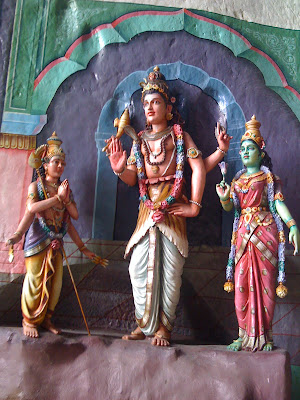The holidays are over, and I suddenly remembered my shopping experience (more on window shopping, I think, and roaming around out of curiosity) at Malaysia. One of the interesting shopping spots I got to visit was Jalan Petaling. It's the Chinatown of Malaysia.

Petaling Street (Malay: Jalan Petaling) is a Chinatown located in Kuala Lumpur, Malaysia. It is infamous for pirated clothes and accessories along with bootleg DVDs and CDs. Petaling Street however does not exclusively offer pirated products. Haggling is a common sight here and the place is usually crowded with locals as well as tourists.
The area has dozens of restaurants and food stalls, serving local favorites such as
Hokkien mee,
Ikan bakar (barbecued fish),
asam laksa and curry noodles. Traders here are mainly Chinese but there are also Indian, Malay, and Bangladeshi traders.
The original Chinatown centered on Market Square. High Street, now known as Jalan Tun H.S. Lee, became increasingly popular as it was higher than the rest of the town and therefore less prone to floods. The wealthier and more ornate shop houses were built north of Jalan Cheng Lock, closer to the business center.
Kuala Lumpur was a typical pioneer town at the turn of the century, filled with a rough and tough population that was largely male.
They were largely Cantonese and Hakkas who came to the city because of the tin trade, working as coolies in the mines. They were governed by Chinese Kapitan or headmen. The most famous Chinese Kapitan is Yap Ah Loy, a Hakka.
In 1870, civil war erupted with the Chinese community being split along partisan lines into the Cantonese Ghee Hin and the Hakka Hai San secret societies. The British were called in to help end the strife but many of the buildings in the settlement were burnt down or severely damaged.
During the Selangor Civil War, the tin mines were abandoned and when the miners returned after the war, they found that the mines were flooded and therefore could not work. Yap Ah Loy persuaded the miners and coolies to remain in KL and the Malays in surrounding districts to grow rice and other garden products. He opened a Tapioca Mill in Petaling Street where the tubers from his farms were brought here to be ground into flour. Petaling Street is still fondly called ‘Chee Cheong Kai’ in Cantonese which means starch factory street.
There is a McDonalds on the first shop lot of Petaling Street. Located inside Petaling street is a three-star business-class and hostel-like: Hotel Malaya and Swiss Inn Hotel, and no frills hotel, Stayorange Hotel. Also near there is a Chinese bookshop and a few stalls selling Hainanese chicken rice and noodles. A small longan stall is also located there.
Nearby is Masjid Jamek, an old mosque of Moorish architecture while a tourist spot known as Central Market is within walking distance. Also nearby are the Pasar Seni LRT station of the Kelana Jaya Line and the Maharajalela Monorail station.
One of the most famous landmarks, the Sri Mahamariamman Temple, Kuala Lumpur, is located along Jalan Tun H.S. Lee is KL's chinatown. It is one of KL's oldest and richest Hindu temples. It receives many devotees and tourists daily.
In 2003, the road underwent a major RM11.3mil face lift with two large Chinese arches placed at both ends of the street to welcome visitors. It still pulls in many tourists, who go there to shop and will be regarded as a heritage site.
However, Petaling Street is still the best place to shop for counterfeit branded products and has large selection of local Chinese cuisine. For buyers, it is often possible to negotiate the price tag of an item such as watches, clothing and all counterfeit items.
Today the iconic "Green Dragon" covers Petaling Street.
Source: Wikipedia

 I went to the grocery to look for Malaysian spices, especially those used for Nasi Lemak, a delicious coconut-milk rice dish.
I went to the grocery to look for Malaysian spices, especially those used for Nasi Lemak, a delicious coconut-milk rice dish.



































